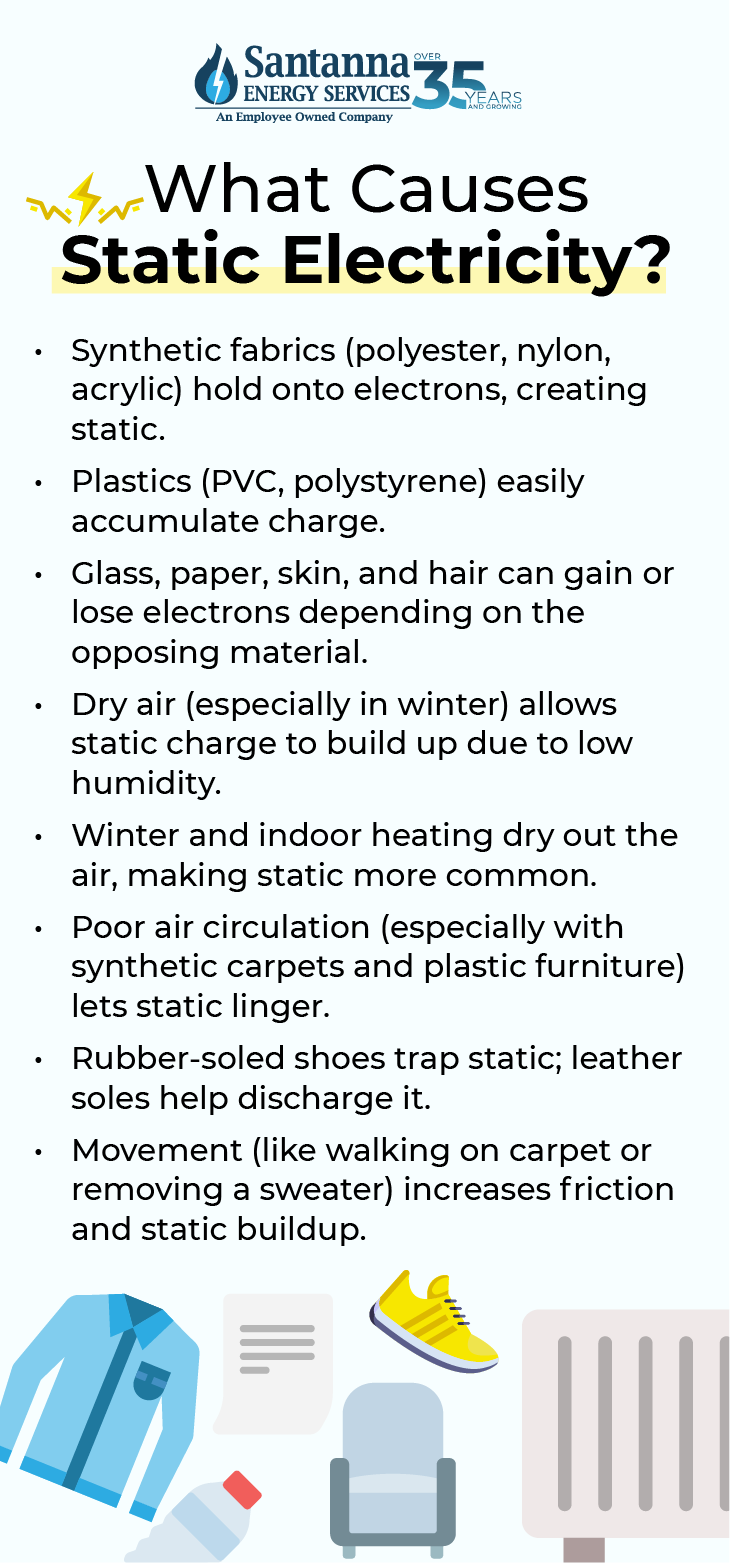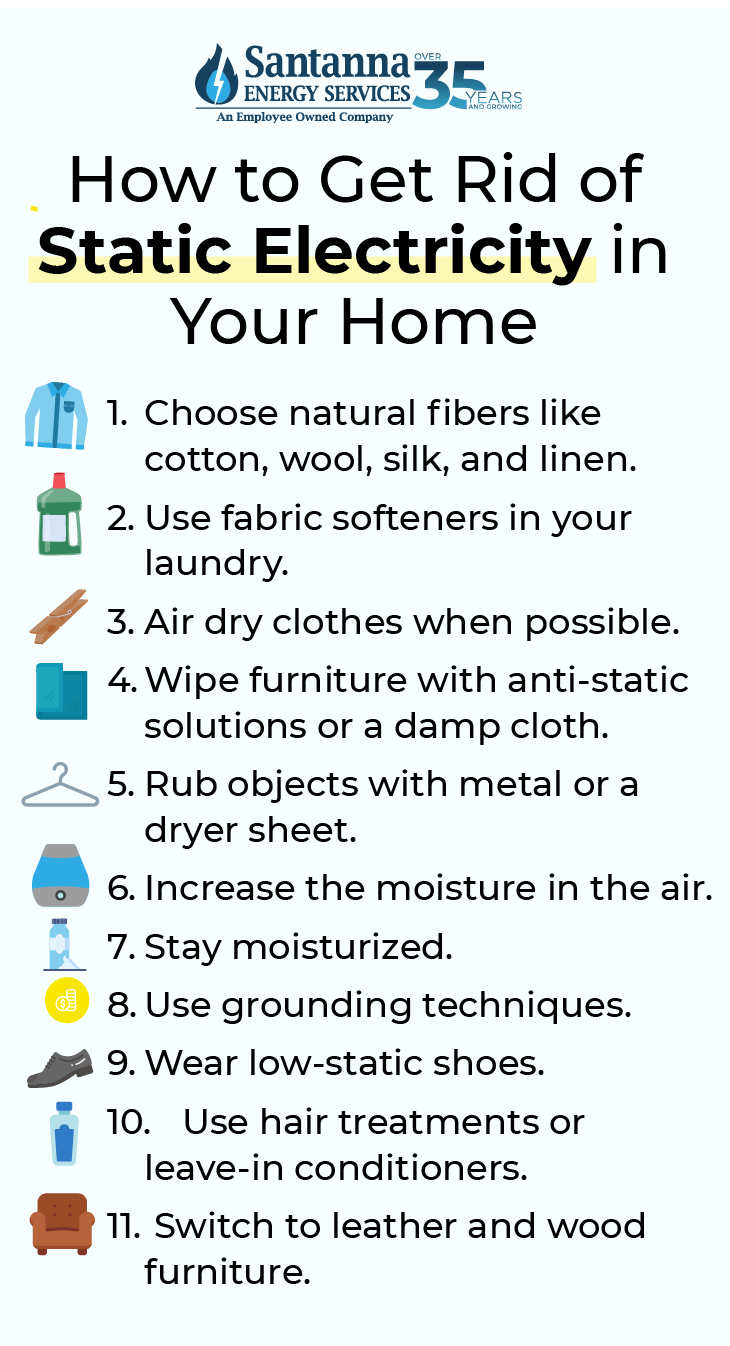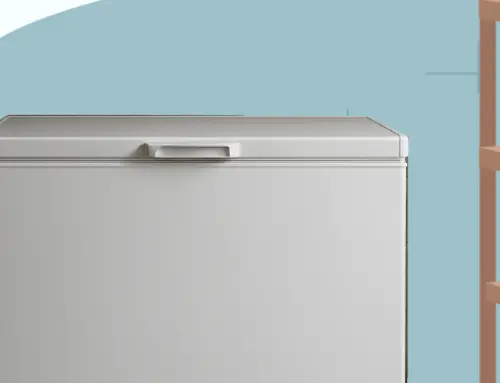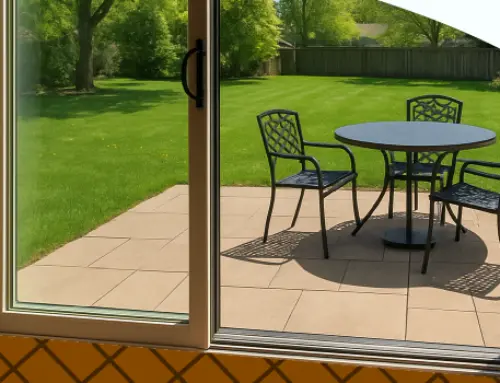How to Get Rid of Static Electricity
by Tyler Castle
24.8 min read

Static electricity is a common occurrence that causes sudden shocks or makes fabrics stick together. While often perceived as a minor inconvenience, understanding how it works is crucial for effective management and prevention. Let's delve into the nature of static electricity, its potential hazards, causative factors, and strategies on how to get rid of static electricity in your home!
What is Static Electricity?
Static electricity, also known as electrostatics, is a natural phenomenon that occurs when there's an imbalance of electric charges on a material's surface. Ever felt a little zap when touching a doorknob or noticed your clothes sticking together? That's static electricity!
But what exactly causes static electricity? It happens when two different materials come into contact and then separate, causing electrons to transfer between them.
Unlike the electricity that powers our homes, static electricity doesn't flow in a continuous circuit—it builds up and stays put until it suddenly discharges. This is why you might experience a small spark or shock when touching metal objects or feel your hair stand on end after pulling off a sweater. The cause of static electricity lies in friction, material composition, and environmental conditions.
How It Happens in Everyday Life
Static electricity builds up when electrons transfer between surfaces, and some activities make it more noticeable than others. From the jolt you get touching a doorknob to dust mysteriously clinging to your TV screen, static electricity at home is everywhere. Here are the most common ways in which it happens in your home:
One of the most common culprits is shocks from metal objects. If you've ever walked across a carpet and then touched a doorknob, you've felt that sudden zap! As you move, your body collects extra electrons, and the moment you touch a metal surface, the charge quickly discharges—resulting in that tiny but startling shock.
Then there's clinging clothes, which are especially annoying when pulling laundry out of the dryer. Synthetic fabrics like polyester and nylon rub against each other, creating static buildup. When you try to separate them, they stick like magnets!
Static also shows up in fun ways—like the balloon and hair effect. Rubbing a balloon against your hair transfers electrons, making your hair strands stand on end as they're attracted to the balloon. Kids love this trick, but it's the same principle that causes other static-related surprises around the house.
Even dust attraction is influenced by static electricity. Ever noticed how your TV screen or laptop collects dust faster than other surfaces? That's because static charges in electronics pull in tiny airborne particles, making screens dust magnets.
What Causes Static Electricity?
Some causes of static electricity come from a mix of materials, environment, and personal habits. Static electricity at home is common, and while it's usually harmless, it can be frustrating when your clothes stick together, your hair won't settle, or you get a surprise shock from touching a doorknob. Let's break down why this happens and what causes static electricity.
1. Material Interaction
Some materials have a stronger ability to gain or lose electrons, a property known as electron affinity which refers to how much a material likes to take in extra electrons when it comes into contact with another material. When two materials with differing electron affinities come into contact and separate, one transfers electrons to the other, creating an imbalance of charge—this is what causes static electricity.
Common materials that generate static include synthetic fabrics like polyester, nylon, and acrylic, which tend to hold onto electrons. Another type are plastics such as PVC and polystyrene, which easily accumulate charge. Also, glass, paper, and even human skin and hair, which can either gain or lose electrons depending on the opposing material can cause static electricity.
2. Environmental Factors
Your surroundings play a big role in what causes static electricity, especially when it comes to humidity levels. Dry air (especially in winter) allows static charge to build up because there's not enough moisture in the air to help electrons disperse. Low humidity equals more static cling, more shocks, and more flyaway hair.
Other environmental factors include temperature and seasonality as static is more common in winter when indoor heating dries out the air. The lack of moisture allows static charges to build up more easily on surfaces, fabrics, and even skin. Air movement also plays a role in causing static electricity, as enclosed spaces with little air circulation, especially rooms with synthetic carpeting and plastic furniture, allow static charges to linger longer.
That's why many people experience more static electricity at home during colder months or in dry climates—there's simply not enough moisture to neutralize the charge.
3. Personal Factors
Your clothing, footwear, and even how you move throughout the day can all influence what causes static electricity.
Clothing choices play a major role, as synthetic fabrics generate more static than natural fibers like cotton and wool. Layering synthetic fabrics can make the problem even worse by increasing friction and charge buildup. In the same way, rubber-soled shoes trap static charge, preventing it from dissipating, while leather-soled shoes help discharge it more efficiently.
Activity and movement throughout the day contribute as well, such as walking across a carpet in socks or rubber soles, rubbing hands on different surfaces, or pulling off a synthetic sweater, all of which increase static buildup.

How to Get Rid of Static Electricity
Static electricity can be annoying, leading to sudden shocks, clingy fabrics, and flyaway hair. If you're wondering how to remove static electricity, here are some effective methods that will keep you static-free:
1. Use Anti-Static Sprays
One of the easiest and most effective ways to get rid of static electricity is using anti-static sprays. These sprays create a thin, invisible coating that prevents charge accumulation, making them perfect for synthetic fabrics, carpets, and upholstery, which tend to generate the most static.
To remove static electricity, spray a light mist over couches, carpets, curtains, and upholstery, and for a DIY alternative, mix one part fabric softener with five parts water and apply lightly to fabrics, repeat as needed, especially during dry seasons when static is more common.
2. Rub Objects with a Dryer Sheet or Wool Dryer Ball
Dryer sheets and wool dryer balls are great for neutralizing static electricity at home, especially on furniture and fabrics. Dryer sheets contain anti-static agents that neutralize electrical charges, while wool dryer balls help reduce friction, preventing static buildup.
To reduce static buildup, lightly rub a dryer sheet over fabric surfaces, cushions, and curtains for furniture and upholstery. Be sure to place a few dryer sheets under area rugs or rub them over the surface for carpets, and for long-term prevention, toss a dryer sheet in the dryer when washing upholstery covers.
3. Increase Moisture in the Air
Static electricity thrives in dry environments, especially during winter when indoor heating removes moisture from the air. Increasing indoor humidity is one of the best long-term ways to remove static electricity and keep it from coming back.
Maintaining indoor humidity between 30-50% helps prevent static from clinging to fabrics and furniture, making your home more comfortable. One of the best ways to achieve this balance is by placing a humidifier in frequently used rooms like the bedroom and living area, ensuring consistent moisture levels throughout your space.
If you don't have a humidifier, you can increase moisture in the air naturally by placing bowls of water near heat sources like radiators or sunny windows to allow evaporation. Using houseplants such as peace lilies, ferns, and spider plants can also help, as they release moisture through transpiration.
4. Ground Large Rugs with Metal Objects
Carpets and rugs can be major sources of static buildup but grounding them with metal helps get rid of static electricity. Metal conducts electricity, allowing excess charge to transfer to the ground.
To get rid of static electricity in rugs, attach a safety pin, aluminum foil, or a small piece of metal to the underside of the rug to help dissipate excess charge. For larger rugs, placing a thin copper wire along the edges can be even more effective in neutralizing static.
5. Remove Static Electricity Before Touching Objects
Metal objects act as conductors, helping to discharge static safely before you touch sensitive surfaces. Using your knuckles instead of fingertips reduces the intensity of shocks because knuckles have thicker, less sensitive skin.
To discharge static and prevent shocks, hold a metal key, coin, or wire hanger and touch it to a metal surface before making direct contact with your hands. Additionally, tapping a metal surface periodically throughout the day helps prevent static buildup and keeps you shock-free.
6. Stay Moisturized
Dry skin is an insulator, allowing static charge to accumulate instead of dissipating naturally. Keeping your skin hydrated helps neutralize static buildup and prevents sudden shocks.
To stay moisturized, apply lotion or moisturizing creams regularly, especially in dry weather. Oil-based or glycerin-rich moisturizers are particularly effective because they create a protective barrier that helps prevent static accumulation. Focus on hands, arms, and legs, as these areas are most exposed to static buildup throughout the day.
7. Wear Low-Static Shoes
The type of footwear you choose plays a significant role in static buildup. Rubber soles act as insulators, trapping electrical charge and making static shocks more likely when you touch a conductive surface. On the other hand, leather-soled shoes help dissipate static by allowing the charge to flow naturally, reducing the risk of buildup.
To minimize static buildup, opt for leather-soled shoes instead of rubber-soled ones, especially in environments with synthetic carpets, since rubber acts as an insulator and prevents charge from dispersing. If leather shoes aren't an option, apply anti-static spray to your shoe soles to help reduce static retention. Additionally, walking on wood or tile floors instead of carpets can further prevent charge buildup and keep static electricity under control.
8. Use Grounding Techniques
One effective method for getting rid of static electricity is using grounding techniques. Grounding helps neutralize built-up static charge before it discharges unexpectedly, preventing sudden shocks. By touching grounded metal objects—such as a metal table leg, filing cabinet, or even a doorknob—you allow excess charge to dissipate safely.
Use anti-static wrist straps or grounding mats when working with electronics to prevent static-related damage. In extremely dry environments, keep a small piece of metal (like a coin or key) in your pocket and touch it before handling electronic devices.
9.Use Hair Treatments or Leave-In Conditioners to Prevent Static
Static electricity in hair can be frustrating, causing flyaways, frizz, and strands that cling to clothing. If you're looking for another way to remove static electricity from your hair, the key is moisture and protection. Using the right hair treatments and leave-in conditioners helps lock in hydration, smooth cuticles, and prevent static buildup. These products create a protective barrier that reduces friction, keeping your hair sleek, manageable, and free from annoying static.
To prevent static buildup in hair, apply a leave-in conditioner after washing your hair to lock in moisture and prevent dryness, which can make static worse. Using hair oils or serums, such as argan oil or coconut oil, helps coat the strands, reducing friction and preventing static cling. It's also important to avoid overwashing, as frequent shampooing can strip the hair of its natural oils, leading to increased dryness and static buildup.
10. Switch to Metal Combs Instead of Plastic
Switching to a metal comb instead of a plastic one is a simple yet effective way to reduce static in your hair. Metal is a conductor, meaning it allows static charges to dissipate instead of building up, preventing flyaways and frizz. In contrast, plastic combs act as insulators, increasing friction and making hair more prone to static electricity. Additionally, metal combs help distribute natural scalp oils, keeping hair moisturized and reducing dryness—one of the main causes of static buildup.
If a plastic comb is your only option, lightly mist it with water or anti-static spray before use to minimize static. Additionally, avoid excessive brushing, as too much friction can generate static and make hair harder to manage.
11. Wear Grounding Bracelets or Use Anti-Static Mats
Another effective method for getting rid of static electricity is using grounding bracelets or anti-static mats. These tools work by redirecting static electricity away from your body, preventing excess charge from accumulating. While commonly used in electronics work to protect sensitive devices, they are also helpful for individuals who frequently experience static shocks. Wearing a grounding wristband helps keep your body neutralized, reducing static buildup on your hair and skin, and providing a simple, long-term solution for managing static electricity.
To effectively remove static electricity, wear a grounding bracelet made of conductive materials like copper or carbon to allow static to dissipate safely before it builds up. Also, place an anti-static mat in areas where static is common, such as desks, workstations, or grooming areas, to minimize charge accumulation. If a grounding device isn't available, simply touch a metal surface, like a doorknob or metal table, before handling personal care items to prevent unexpected shocks.

How to Get Rid of Static Electricity in Clothing
If you've ever dealt with clingy clothes that won't let go or a surprise shock while getting dressed, you're not alone! Here's how you get rid of static electricity in clothing:
1. Choose the Right Fabrics
The type of fabric you wear plays a huge role in preventing static buildup. Some materials naturally hold onto charge, while others help dissipate it. Choosing the right fabrics is one of the simplest ways to get rid of static electricity in clothing before it even starts.
One of the most effective ways to get rid of static electricity in clothing is by choosing natural fibers like cotton, wool, silk, and linen. These fabrics absorb moisture, which helps reduce static buildup and allows electric charges to dissipate more easily. Wearing 100% cotton or linen clothing is a great way to prevent static cling, and if you need to wear synthetic fabrics, layering them over natural fibers can help balance charge buildup.
On the other hand, synthetic materials like polyester, nylon, and acrylic are known for generating and holding onto static. These fabrics act as insulators, trapping charge and increasing friction, which leads to more static buildup. If you love synthetic fabrics for their durability or stretch, try mixing them with natural fibers to minimize static. Even better, opt for anti-static treated synthetic garments when possible, as these are designed to reduce static electricity in clothing.
2. Wash Clothes the Right Way
Getting rid of static electricity in clothing starts with how you wash and dry your clothes. The right laundry routine can reduce static buildup and keep your clothes feeling fresh, soft, and cling-free.
Fabric softeners are a simple yet effective solution for how to get rid of static electricity in clothing. These products coat clothing fibers, reducing friction and preventing static buildup while also leaving clothes feeling softer and less likely to cling. To use fabric softeners effectively, add liquid fabric softener during the rinse cycle or toss dryer sheets into the dryer to further neutralize static. If you prefer a natural option, white vinegar in the rinse cycle works wonders—softening fabrics while neutralizing static without leaving any strong odors.
3. Air Dry Instead of Machine Drying
Over-drying clothes in a heated dryer is one of the biggest causes of static buildup. Excessive heat removes too much moisture, making fabrics more likely to cling together and shock you when you take them out.
Instead, air drying helps fabrics retain natural moisture, preventing static from forming in the first place. If possible, hang synthetic fabrics to air dry instead of tossing them in the dryer. If you must use a dryer, remove clothes while they're still slightly damp to avoid over-drying and unnecessary static.
4. Separate Synthetic and Natural Fabrics
Another important tip for getting rid of static electricity in clothing is to separate fabrics before drying. Mixing synthetic fabrics like polyester and nylon with natural fibers like cotton and wool can lead to static transfer, making all clothes more clingy.
Since synthetic fabrics hold onto charge longer, they can amplify static buildup when dried alongside natural fibers. To minimize this effect, dry synthetic and natural fabrics separately whenever possible. If you have to mix them, use dryer balls or toss in a damp washcloth to help reduce static.
5. Use Anti-Static Solutions
If you're tired of dealing with clingy clothes and annoying shocks, using anti-static solutions is one of the most effective ways to get rid of static electricity in clothing.
A quick and easy fix for static electricity in clothing is using anti-static sprays. These sprays neutralize charge buildup, preventing fabrics from clinging together and sticking to your body. For best results, lightly mist your clothing with a store-bought anti-static spray before wearing. Prefer a DIY approach? Simply mix one part fabric softener with five parts water and spray it lightly on clothes to reduce static throughout the day.
6. Add Baking Soda
If you're looking for a natural, chemical-free way to remove static in clothing, baking soda is a game-changer. It softens fabrics naturally, reducing friction between fibers and preventing static buildup.
By balancing pH levels, it creates a neutral environment in the wash, which helps prevent excessive charge accumulation. Additionally, it increases moisture retention, keeping fabrics from becoming overly dry and reducing the chance of static cling. As a chemical-free alternative, it works as a natural fabric softener without the need for artificial additives.
To use it effectively, add ½ cup of baking soda directly into the washing machine drum before starting a load. For even better results, pair it with white vinegar by adding vinegar to the fabric softener compartment. If static is still a problem, toss wool dryer balls into the dryer to further reduce friction and keep clothes soft and static-free.
How to Remove Static Electricity on Furniture
If you've ever experienced an unexpected zap when sitting on the couch or noticed fabric clinging to your furniture, you're dealing with static electricity at home. Here are simple and effective ways on how to get rid of static electricity on furniture:
1. Wipe Surfaces with a Damp Cloth
One of the easiest ways to remove static electricity at home is by adding a bit of moisture to furniture surfaces. Water is a natural conductor, meaning it helps neutralize static buildup and prevents charge retention. Dry environments make static worse, so introducing a little humidity can make a big difference.
To do this, lightly dampen a microfiber cloth or paper towel with water or a diluted fabric softener solution (a few drops mixed in a spray bottle of water). Gently wipe down sofas, chairs, curtains, and other upholstered surfaces to remove static. However, be careful not to over-wet materials, as excess moisture could damage certain fabrics.
2. Run a Metal Object (Like a Wire Hanger or Key) Along Furniture
Another quick and effective method how to remove static electricity on furniture is using a metal object to discharge built-up static. Metal acts as a conductor, allowing excess charge to dissipate from non-conductive surfaces like upholstery and fabric.
Simply run a metal hanger, key, or even a ball of aluminum foil along your furniture, carpets, or curtains to instantly reduce static buildup. If your carpeted floors contribute to the problem, dragging a metal object across the surface can help prevent static shocks. For extra protection, hold a metal key and tap it against furniture before sitting down—this helps discharge any lingering charge and prevents that unpleasant zap.
3. Use Dryer Sheets on Furniture
Dryer sheets aren't just for laundry—they're also a great tool for reducing static electricity at home. These sheets contain static-reducing compounds that help neutralize electrical charges on fabric surfaces, preventing cling and shocks.
To use them, simply rub a dryer sheet lightly over furniture, curtains, or carpets to instantly reduce static. For longer-lasting results, tuck a few dryer sheets between sofa cushions or under seat covers to keep static at bay throughout the day.
4. Place Houseplants in the Room
A natural and effective way to get rid of static electricity on furniture is by adding houseplants to your space. Plants release moisture into the air, increasing humidity and reducing static buildup on furniture and fabrics.
Choosing the right plants can make a big difference—peace lilies, spider plants, and Boston ferns are all excellent choices for maintaining indoor humidity. To maximize their effect, place plants near furniture where static is most noticeable and water them regularly to keep the air naturally humid.
5. Switch to Leather or Wood Furniture
The materials your furniture is made of can impact static electricity at home. Leather and wood surfaces don't generate as much static as synthetic or upholstered fabrics, making them a better choice for a static-free space.
If you're prone to static issues, consider replacing or covering fabric furniture with leather, faux leather, or wood surfaces. If replacing furniture isn't an option, use leather conditioner to maintain moisture in existing leather seating.
Tips for Managing Static During Different Weather Conditions
Static electricity behaves differently depending on the season and climate. Adjusting your habits and environment can help minimize static shocks and clingy fabrics year-round. Below are some tips for managing static electricity during different weather conditions:
During Winter (Cold, Dry Air = More Static)
Winter is the worst season for static buildup because cold air holds less moisture, and indoor heating further dries out the air, making it easier for static to accumulate. Here are some tips to manage static electricity during winter:
- Increase humidity indoors by using a humidifier, houseplants, or bowls of water near heat sources to maintain moisture in the air.
- Opt for natural fibers like cotton, wool, and silk instead of synthetic fabrics that generate more static.
- Layer wisely by wearing cotton as your base layer when dressing in synthetic fabrics like fleece to help reduce static transfer and prevent cling.
- Keep skin moisturized with oil-based lotions to prevent dryness, which increases static retention.
- Use anti-static spray on carpets, furniture, and clothing to reduce charge buildup.
- Wear leather-soled shoes instead of rubber soles, which insulate and trap static charge.
- Reduce friction by using fabric softeners or dryer sheets when washing clothes.
- During Summer (Warm, Humid Air = Less Static)
Static is less of an issue in summer because warm air holds more moisture, allowing static charges to dissipate more easily. However, air conditioning can dry out indoor air, leading to unexpected static buildup. Here are some tips to manage static electricity during summer:
- Wear moisture-wicking fabrics like cotton and bamboo, which help maintain balance and prevent excessive static buildup.
- Use a light humidifier in air-conditioned environments to prevent dryness that increases static indoors.
- Stay hydrated and moisturized – Even though humidity is higher, dry skin can still retain static if you're frequently indoors.
- Choose footwear wisely – Flip-flops and leather sandals allow charge to dissipate naturally, while rubber-soled shoes trap static.
- Use an anti-static hair serum to prevent flyaways caused by summer heat and friction.
- Use lightweight bed linens – Lighter, breathable fabrics (like cotton) reduce static buildup caused by friction from heavier materials in humid summer air.
- Avoid synthetic swimwear – Wet synthetic fabrics (like nylon swimsuits) can cling and create static. Opt for natural fiber cover-ups instead.
During Rainy or Humid Conditions (Moist Air = Static-Free, But Other Issues Arise)
Rain and humidity help neutralize static naturally, but excessive moisture can affect electronics and increase mold risks indoors. Here are some tips to manage static electricity during rainy or humid conditions:
- Let humid weather work for you – Clothing is less likely to cling, and static shocks are minimal when humidity is high.
- Use moisture-absorbing products like dehumidifiers or silica gel packs to protect electronics from excess dampness.
- Be mindful of excess moisture on floors – If walking on damp carpets, static buildup is less likely, but you might experience electrical shocks near outlets due to high conductivity.
- If humidity drops after a rainstorm, static can return – Keep a small anti-static spray on hand for clothes and furniture.
- Protect hair from humidity-induced frizz by using an anti-static or anti-humidity hair spray.
Is Static Electricity Dangerous?
For most people, static electricity is nothing more than an occasional nuisance—causing mild shocks, clingy clothes, and flyaway hair. However, in certain environments, static electricity can pose real risks. While a typical static discharge is harmless, in places with flammable gases or dust, even a small spark from static electricity can ignite an explosion.
This is why industries that work with gas, chemicals, or fine powders take extra precautions to control static buildup. Additionally, sensitive electronic components can be damaged by static discharges, leading to malfunctions in important devices such as computers, medical equipment, or home appliances.
For most individuals, the human impact of static electricity is limited to mild shocks, which—while surprising—are generally not harmful. However, people with medical devices like pacemakers should be more cautious, as strong static discharges could potentially interfere with device functionality.
Why Do I Have So Much Static Electricity?
Ever wondered why you have so much static electricity? Static buildup happens when excess electrons accumulate on surfaces—including your clothing, body, and furniture—without a way to discharge. Let's delve into several factors that influence how much static electricity you experience daily.
One of the biggest culprits is clothing choices. Wearing synthetic fabrics like polyester, nylon, or fleece increases static retention because these materials don't allow electrical charge to dissipate easily. If your outfits tend to cling or give you little shocks when you take them off, your fabric choices might be to blame.
Another key factor is footwear such as rubber-soled shoes that act as insulators, preventing charge from dissipating and making static buildup worse. Switching to leather-soled shoes can help discharge excess electricity and reduce shocks throughout the day.
Your indoor environment also plays a major role. If you live in a low-humidity environment or use forced-air heating, the dry air makes it easier for static to build up and harder for charges to disperse.
Additionally, your activity level affects how much static you generate—walking on carpeted floors, especially while wearing rubber-soled shoes, increases friction and leads to greater charge accumulation.
Finally, personal body composition can play a role in why some people experience more static than others. Body chemistry and hydration levels influence how easily you build up static, meaning some individuals naturally retain more charge than others.
If you frequently experience static shocks, consider small lifestyle adjustments like wearing natural fabrics, increasing indoor humidity, and switching to leather-soled shoes to help reduce static buildup.
How Can You Prevent Static Electricity?
Static electricity can be managed effectively by making small adjustments in clothing choices, environmental conditions, and daily habits. Here's a more detailed breakdown of how you can prevent static electricity:
One of the most effective ways to prevent static electricity is by modifying your clothing and fabric choices.
1. Wear Natural Fibers
Natural fibers like cotton, wool, and silk absorb moisture better than synthetic fabrics, helping static charges dissipate instead of accumulating. In contrast, synthetic materials like polyester, nylon, and acrylic tend to trap charge, making them more prone to static buildup. If you prefer synthetic fabrics, layering them with cotton-based materials can reduce static buildup.
2. Use Anti-Static Sprays or Fabric Conditioners
Another simple solution to prevent static electricity is using anti-static sprays or fabric conditioners. Spraying an anti-static product on your clothes before wearing them can help neutralize charges, preventing them from clinging. In the laundry, adding liquid fabric softener helps coat fibers, reducing friction and static.
3. Wash and Dry Clothes Differently
Washing and drying clothes differently can prevent static electricity. Avoid over-drying clothes in the dryer, as completely dry fabrics rub against each other and generate more static. Instead, add a damp washcloth or a ball of aluminum foil to help discharge static while drying. If possible, air-drying synthetic fabrics is another great way to minimize static buildup.
4. Use Natural Materials for Furniture and Upholstery
Plastic, vinyl, and synthetic upholstery tend to trap static electricity, making shocks more frequent. Choosing wooden or leather furniture instead of synthetic materials helps reduce static buildup.
5. Keep Skin Moisturized
Dry skin retains static charge, making you more likely to experience static shocks. Applying lotion regularly, especially in winter, helps prevent dryness and reduces static buildup on your body. Oil-based or glycerin-based lotions work best, as they create a protective barrier that prevents moisture loss and helps dissipate static more effectively.
6. Discharge Static Before Touching Electronics or Metal Objects
If you frequently experience shocks when touching doorknobs, electronics, or metal surfaces, learning how to safely discharge static electricity can help. Before touching sensitive items, tap a grounded metal object like a metal door handle, filing cabinet, or a metal chair leg. This simple action allows the excess charge to dissipate safely.
7. Use Anti-Static Mats or Wrist Straps When Handling Electronics
If you frequently work with computers, smartphones, or other delicate electronics, using an anti-static wrist strap or grounding mat prevents static discharge that could damage delicate circuits. These can help neutralize excess charge, protecting sensitive circuits from damage.
Static electricity, while often just an everyday annoyance, can become a bigger issue when it leads to clingy clothing, unexpected shocks, or even risks in sensitive environments. Learning how to get rid of static electricity starts with understanding its causes, seasonal triggers, and the best ways to manage it effectively. By making simple changes, you can take control of static buildup and prevent it from disrupting your daily life.
Tyler is an experienced energy professional, having worked for Santanna Energy Services, for the past four years. He is passionate about renewable energy and believes that diversifying the energy grid is the key to a sustainable future. Tyler is dedicated to supplying consumers with the best possible energy solutions and works diligently to make sure that Santanna can deliver the highest quality service.







